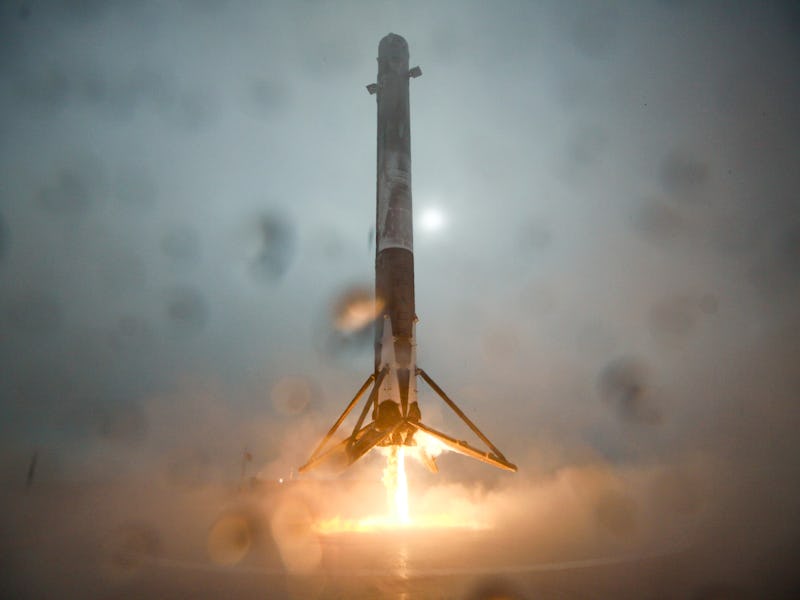SpaceX Starlink: Photo shows how Falcon 9 missed birds with failed landing
A SpaceX Falcon 9 booster met a watery end in the latest Starlink launch.

SpaceX may have avoided a flame-grilled disaster with its latest launch.
On Monday at 10:59 p.m. Eastern time, the firm launched 60 satellites for its Starlink internet connectivity constellation. It was the sixth launch for this Falcon 9 booster, and the plan after Monday's launch was to land on the Of Course I Still Love You drone ship.
Unfortunately, the booster failed to land — just as well, too, as the firm's live feed showed three birds perched on the ship's deck. The Falcon 9's Merlin engines, used to slow down the booster for a soft landing, could have charbroiled these feathered friends.
"That booster saved SpaceX from a seagull barbeque public relations nightmare," wrote NASASpaceflight reporter Michael Baylor on Twitter. "B1059-6 was an honorable sacrifice."
Want to know more about SpaceX's plans for Starlink? Subscribe to MUSK READS+ for exclusive interviews and analysis about all things Musk.
The drone ship before the landing.
The failure is notable as SpaceX has developed an impressive track record for booster recovery. The firm only landed five of the eight boosters it launched in 2016, but in 2020 it landed 23 of the 26 it launched. As a sign of its improving track record, 21 of the boosters that flew in 2020 had flown on previous missions.
Why did the SpaceX booster landing fail?
SpaceX has not released a statement explaining what happened. In an analysis shared Wednesday, YouTuber Scott Manley compared the launch footage with a successful February 3rd Starlink launch with almost the same flight profile:
Manley argued that, based on telemetry data and visual comparisons, there may have been a more reasonable explanation for the booster mishap: engine failure that caused the booster to fail its landing.
That didn't stop SpaceX fans from joking that the booster missed its landing to save the birds on the deck.
"Booster B1059 sacrificed itself when it saw birds," wrote YouTube user Ryan Herbison on the live feed. "Rest in pieces."
Other aspects of the return fared more successfully. SpaceX CEO Elon Musk highlighted on Twitter Tuesday that the firm successfully caught an active fairing half, the protective shield used with payloads.
This was the sixth flight for the B1059 booster:
- The first was the 19th Commercial Resupply Services mission on December 5, 2019, which launched vital cargo to the International Space Station.
- The second was the 20th Commercial Resupply Services mission on March 7, 2020.
- The third was the ninth batch of Starlink satellites on June 13, 2020. This mission also sent up three satellites for San Francisco-based firm Planet.
- The fourth was the SAOCOM-1B mission on August 31, 2020.
- The fifth was the NROL-108 mission on December 20, 2020.
The launch, named "Starlink-19," sent up 60 Starlink satellites for the growing constellation. The company has launched over 1,000 satellites in total. SpaceX aims to offer satellite internet with speeds of up to one gigabit per second and latencies in the tens of milliseconds. It does this by orbiting the satellites much closer to the Earth, at around 550 kilometers (341 miles) altitude.
The firm started its "Better Than Nothing" internet service beta test last year. Users in the United States, Canada, and the United Kingdom have been invited to test the service, with fans reporting speeds of around 150 megabits per second. The firm charges users in the United States $499 for the kit, plus $99 per month for the service.
The Inverse analysis — SpaceX's loss is unfortunate, but the firm may have already made its money back on the booster's construction.
There is a debate around how many relaunches a booster needs before it pays for itself. Tory Bruno, CEO of United Launch Alliance, claimed in April 2020 a rocket needed to fly 10 times. Musk responded that three would "definitely" be enough, as the payload reduction due to reusability is around 40 percent for Falcon 9.
It didn't make the magic 10, but it's perhaps enough to cover the costs.
SUBSCRIBE TO MUSK READS+, A PREMIUM NEWSLETTER THAT COVERS THE WORLDS OF ELON MUSK, SPACEX, TESLA, AND EVERYTHING BETWEEN.
This article was originally published on